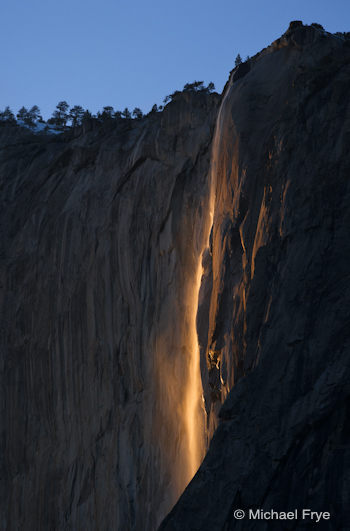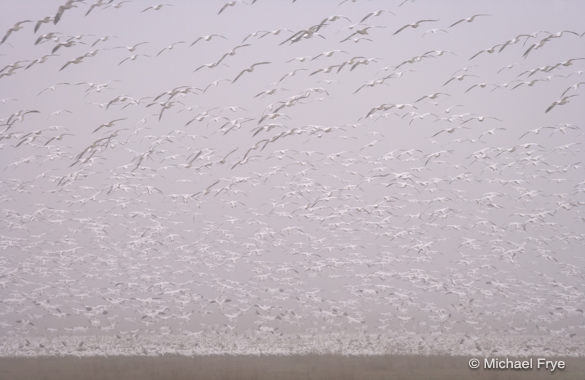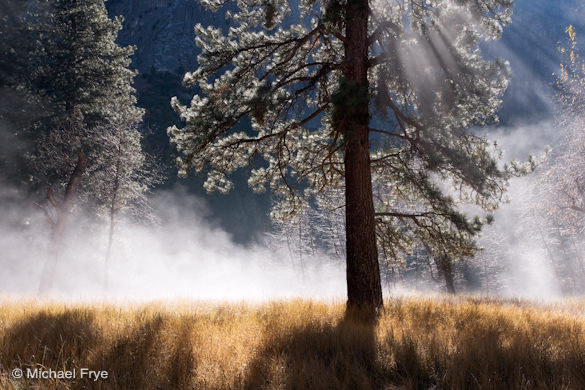In the Moment:
Michael Frye's Landscape Photography Blog
by Michael Frye | Feb 8, 2011 | Yosemite Photo Conditions

Horsetail Fall, February 22nd, 2010
It’s here—almost. The window of best light on Horsetail Fall will begin around February 12th and continue until approximately February 22nd this year. The big questions is how much water will be in the fall.
Horsetail Fall is fed by snow melting from a small area on top of El Capitan. While there was plenty of snow up there in December, we’ve had only one small storm since January 2nd, and much of that early-winter snowpack has disappeared. Horsetail has a decent flow right now, indicating that there’s still some snow on top of El Cap, and I think there will be enough to last through the window of best light—but it might be a close call. If the snowpack holds up, and the warm, dry weather continues, it could be a banner year for Horsetail Fall photographs, with many clear sunsets.
For more details about photographing Horsetail Fall, see this article on my web site, or previous blog posts here and here. And check out the time-lapse video of Horsetail that Steve Bumgardner just posted.
Meanwhile, Yosemite Falls is still going strong, with exceptionally high flow for February, and excellent early-morning light. That light starts to shift soon—by the end of the month it’s not nearly as good. But for the next week or so the sun will strike the upper fall early, creating golden light on the water, and the chance to see rainbows from the eastern end of Cook’s Meadow.
Just to make things more interesting, there will be a full moon the night of February 17th, right in the middle of the Horsetail window. In Yosemite Valley the best opportunities for moonrise photos occur one to three days before the actual full moon date. I recommend using The Photographer’s Ephemeris to figure out the the specifics, but it looks like the moon might be visible near Half Dome at sunset on the 15th from the eastern end of the valley (Cook’s Meadow and the Ahwahnee Meadow). The evening of the 16th you might be able to see a moonrise from Tunnel View. So if you’re in Yosemite one of those days you’ll have to choose between trying to photograph Horsetail Fall or the moonrise.
If you get any good photographs of Horsetail, a moonrise, or anything else in the park, I’d love to see them, so please feel free to post links in the comments. Good luck!
by Michael Frye | Feb 7, 2011 | Announcements

Ross’ geese landing, Merced National Wildlife Refuge
As most of you probably know, last week I posted this image of Ross’ geese from Merced National Wildlife Refuge, and held a little contest to see who could guess the number of geese—in the air—in the photograph. The response was great; 83 people submitted estimates. The guesses covered a wide range, from 300 to 4000. Thanks to all of you who joined in—this has been a lot of fun!
So here’s the actual number of geese, in the air, that I counted: (drumroll please) 1585. The closest guess was 1600, made by Jack Kirchert. Congratulations Jack! Honorable mentions go to Jim Davies, 1560; James Williams, 1545; and Pam, 1543. All these people came within 42 of the actual number. The next closest estimate was 1505, 80 geese away from my count.
Since four people came so close, I’m going to award four prizes: all the people I just mentioned will get their choice of either my Digital Landscape Photography book or one of my three Yosemite posters. In addition, the Grand Prize winner, Jack Kirchert, will receive an 8×10 matted print of this photograph with a congratulatory message and my signature.
Most of the guesses turned out to be too low. The actual count surprised me as well. When I first looked at the image, I thought there might be 600 to 800 birds in the air. But when I started actually counting them (I know, too much time on my hands…) it quickly became apparent that there were a lot more geese than I thought. As I mentioned earlier, this was part of a large flock that arrived to join the birds already on the ground. This photograph shows only a portion of this group of new arrivals, certainly less than half, so this new group might have had 4000 to 5000 birds, joining perhaps another 5000 or more on the ground. An amazing number, and a wonderful sight. (Here’s a larger view of this photograph.)
So thanks again to all who participated, and congratulations to the winners!
by Michael Frye | Feb 3, 2011 | Digital Photography Basics, Photography Tips

Understanding how to read a histogram is the best way to judge exposure in high-contrast scenes like this.
With film, exposure always involves some guesswork—you can never be sure you made the correct exposure until you develop the film. But with digital cameras you can tell immediately whether the right amount of light reached the sensor by looking at a histogram. This ability to instantly evaluate exposure is a game changer—the single biggest advantage of digital photography over film.
But many photographers are still guessing about exposure because they’re unable to decipher the histogram’s cryptic messages. Instead they judge exposure by how bright the image looks on their camera’s LCD screen. But while those little screens are extremely useful for many things, evaluating exposure isn’t one of them. There are too many variables: screen quality (usually bad), the LCD brightness setting in the camera, and the amount of ambient light.
(more…)
by Michael Frye | Feb 1, 2011 | Announcements

Ross’ geese landing, Merced National Wildlife Refuge
Claudia and I had such a great time visiting Merced National Wildlife Refuge last Monday we went back two more times last week. On Wednesday we found a large flock of geese—mostly Ross’ geese—feeding in a field near the tour road. Small groups flew in, joining the group, then a huge flock arrived from the north. This photograph shows only part of this new group landing.
When watching flocks of snow or Ross’ geese like this, it’s always hard to estimate the numbers. You know you’re looking at a lot of birds, but how many? So out of curiosity I counted the number of geese in the air in this photograph. Yes, really, I counted them. I took the image into Photoshop, zoomed in, and marked little dots on each bird to make sure I didn’t miss any or count them twice.
So I thought it might be fun to see if you, my readers, could guess how many birds are in the air in this photograph. And just to add a little incentive, the person who’s estimate comes closest to my count will win a free copy of my book Digital Landscape Photography: In the Footsteps of Ansel Adams and the Great Masters. Or, if you already have a copy, you can choose one of my three posters (you can view them here).
To make your guess and enter the contest, go to my blog home, where you can read the rules, see a larger image, and post your guess in the comments.












